38 mutually exclusive venn diagram
Lesson Explainer: Calculating Probability Using Venn ... We note that the two events are mutually exclusive since the circles in the Venn diagram do not overlap. In other words, there is no number between 1 and 12 which is both a factor of 20 and a multiple of 3. Hence, the probability of this event is equal to 0. Part 3 Mutually Exclusive Outcomes and Events - Mr-Mathematics.com I teach mutually exclusive outcomes directly after students have encountered Venn diagrams. This is the fifth lesson in the Year 8 Probability, Outcomes and Venn diagrams scheme of work.. Before progressing on to mutually exclusive outcomes students review Venn diagrams using the starter question below.
Exhaustive Events - Definition, Venn Diagram, Examples ... It is not necessary for exhaustive events to be mutually exclusive. In other words, we can say that exhaustive events are of two types - mutually exclusive exhaustive events and exhaustive events that are not mutually exclusive. Let us now see the Venn diagram for exhaustive events in a sample space to understand the concept.

Mutually exclusive venn diagram
Mutually Exclusive and Non-Mutually Exclusive Events ... Suppose that event A is rolling an even number and event B is rolling a multiple of 3. Determine whether A and B are mutually exclusive. Events A and B are: , We have: Since A and B intersect, they are non-mutually exclusive. Here is the Venn diagram: Two non-mutually exclusive events satisfy: Independent Events in Probability (Definition, Venn ... Let us learn here the complete definition of independent events along with its Venn diagram, examples and how it is different from mutually exclusive events. What are Independent Events? In Probability, the set of outcomes of an experiment is called events. Venn diagrams - ModelAssist - EpiX Analytics In a Venn diagram the squared area denoted e contains all possible events. The circles represent specific events. Probabilities are represented by the ratios of areas. For example, the probability of event A in the figure below is the ratio of area A to the total area e: Figure 1: Venn diagram for a single event A. Mutually Exclusive Events
Mutually exclusive venn diagram. PDF Mutual Exclusivity, Venn Diagrams and Probability 10. Create a Venn diagram showing the relationship between squares (S), quadrilaterals (Q), rectangles (R) and parallelograms (P). 11. In each separate Venn diagram, shade the region indicated: a) b) c) 12. Let P(A' B) 0.2, P(B) 0.5 and P(A) 0.4 a) Determine whether events A and B are mutually exclusive Mutually Exclusive Events - Definition, Formula, Rules ... Real-life Examples on Mutually Exclusive Events. Some of the examples of the mutually exclusive events are: When tossing a coin, the event of getting head and tail are mutually exclusive. Because the probability of getting head and tail simultaneously is 0. In a six-sided die, the events "2" and "5" are mutually exclusive. Mutually exclusive events - Math Thus, A and B are mutually exclusive events. On the other hand, if we wanted to know the probability of selecting an ace or a king, P(A ∪ B), we would simply sum their individual probabilities: P(A ∩ B) = P(A) + P(B) 1/13 + 1/13 = 2/13. Venn diagrams. Mutually exclusive events can be depicted using Venn diagrams. Independent and Mutually Exclusive Events: Assignment ... Events B and C are non-mutually exclusive. Which Venn diagram could represent this description? D. Josiah takes a multiple-choice quiz that has three questions. Each question has five answer options. If he randomly chooses his answers, what is the probability that he will get all three correct?
Mutually Exclusive and Non-Mutually Exclusive Events ... What does the formula P(A U B) = P(A) + P(B) - P ( A ∩ B) mean?This video covers the concepts of mutually exclusive events and non-mutually events in detail.... Mutually Exclusive and Non-Mutually Exclusive Events ... Mar 24, 2022 · It follows that mutually exclusive events are those that do not share any of the same outcomes. How do we calculate the probability of these events? Let us visualize using a Venn Diagram: If \( A \) and \( B \) are two mutually exclusive events, then the probability of \(A \) or \( B \) occurring is their respective probabilities added together. Probability of Mutually Exclusive Events With Venn Diagrams This probability video tutorial provides a basic introduction into mutually exclusive events with the use of venn diagrams.My Website: ... Difference Between Mutually Exclusive and Independent Events P(A and B) = 0 represents mutually exclusive events, while P (A and B) = P(A) P(A) The sets in a Venn diagram do not overlap each other in the case of mutually exclusive events, but they do overlap in the case of independent events. Questions to Be Solved: Question 1. If we throw a dice twice, then find the probability of getting two 5’s.
Mutually Exclusive Event - an overview | ScienceDirect Topics Fig. 6.4.4 shows a Venn diagram for two mutually exclusive events as two circles that do not overlap. Sign in to download full-size image Fig. 6.4.4. A Venn diagram for two mutually exclusive events, which cannot both happen on a single run of the random experiment. Because the circles do not overlap, there are no points common to both events. Mutually Exclusive Events - Math Goodies We can use set theory and Venn Diagrams to illustrate this difference. Mutually Exclusive Events Two events are mutually exclusive if they cannot occur at the same time (i.e., they have no outcomes in common). In the Venn Diagram above, the probabilities of events A and B are represented by two disjoint sets (i.e., they have no elements in common). Mutually Inclusive vs. Mutually Exclusive Events - Statology Dec 30, 2020 · Visualizing Mutually Inclusive & Mutually Exclusive Events. We often use Venn diagrams to visualize the probabilities associated with events. If two events are mutually exclusive then they would not overlap at all in a Venn diagram: Conversely, if two events are mutually inclusive then there would be at least some overlap in the Venn diagram: Venn Diagram Worksheets | Printable Free Venn Diagram ... Venn Diagrams are often used to represent a set of data that may or may not be mutually exclusive. It helps people to understand complex data easily. Venn diagrams become useful when you need to represent two or more parameters in a given data. Benefits of Venn Diagram Worksheets
Venn diagrams - Probability - WJEC - GCSE Maths Revision ... This is represented on a Venn diagram like this: The fact that the two circles do not overlap shows that the two events are mutually exclusive. This means that the probability of A or B happening =...
Difference Between Mutually Exclusive and Independent ... Mutually exclusive events are represented mathematically as P (A and B) = 0 while independent events are represented as P (A and B) = P (A) P (B). In a Venn diagram, the sets do not overlap each other, in the case of mutually exclusive events while if we talk about independent events the sets overlap. Conclusion
Mutually Exclusive Events - mathsisfun.com Mutually Exclusive Events. Mutually Exclusive: can't happen at the same time. Examples: Turning left and turning right are Mutually Exclusive (you can't do both at the same time) ... Instead of "and" you will often see the symbol ∩ (which is the "Intersection" symbol used in Venn Diagrams)
Events A and B are mutually exclusive. Events B and C are ... answered Events A and B are mutually exclusive. Events B and C are non-mutually exclusive. Which Venn diagram could represent this description? Advertisement Answer 5.0 /5 120 zxch4 Answer: The 4th Venn diagram. (A and B aren't touching, A and B are touching C though.) Still stuck? Get 1-on-1 help from an expert tutor now. correct Advertisement
Mutually Exclusive Events: Definition, Formulas, Notation ... Venn Diagram Representation of Mutually Exclusive Events Two events are shown in circles with the rectangular portion. The common portion of two elements gives the intersection of events; these events are called non-mutual exclusive events. The probability of non-mutual exclusive events (\ (A\) and \ (B\)) is given by using the formula
Mutually exclusive events - Explanation & Examples Draw a Venn Diagram corresponding to these three events and identify mutually exclusive events. Solution: We note from the Venn diagram that $E1$ and $E2$ do not overlap and hence are mutually exclusive. We note from the Venn diagram that $E1$ and $E3$ do overlap and hence are NOT mutually exclusive.
Mutually Exclusive Events - Examples With Solutions Using Venn diagram, two events that are mutually exclusive may be represented as follows: The two events are such that The two sets E1 and E2 have no elements in common and their intersection is an empty set since they cannot occur at the same time. Using Venn diagram, two events that are not mutually exclusive may be represented as follows:
Are venn diagrams mutually exclusive? - All Famous Faqs What does mutually exclusive mean in Venn diagrams? Mutually exclusive means that A and B cannot both happen at the same time. Venn Diagram showing mutually exclusive events: The events 'draw an Ace' and 'draw a Heart' are not mutually exclusive as the Ace of Hearts means both events happen together. Venn Diagram showing.
Venn Diagrams - University of Northern Iowa Two sets are mutually exclusive (also called disjoint) if they do not have any elements in common; they need not together comprise the universal set. The following Venn diagram represents mutually exclusive (disjoint) sets. If the union of two mutually exclusive sets is the universal set they are called complementary.
Venn Diagrams ( Real World ) | Probability | CK-12 Foundation Remember that mutually inclusive events are events that occur at the same time. Then write your answer in set notation. Take a picture of your Venn diagram, or scan it. Then upload it and share it with other CK-12 users! You can also use educreations.com to record your discussion of your Venn Diagram and then upload your video to the CK-12's ...
Independent and Mutually Exclusive Events - Introductory ... Therefore, A and B are not mutually exclusive. A and C do not have any numbers in common so P(A AND C) = 0. Therefore, A and C are mutually exclusive. If it is not known whether A and B are mutually exclusive, assume they are not until you can show otherwise. The following examples illustrate these definitions and terms.
Tree diagrams and mutually exclusive events - Variation Theory Tree Diagrams and Mutually Exclusive Events; 5. Alternative versions. feel free to create and ... of length Units of volume Using place value Using the quadratic formula Value of a decimal Value of a digit Vector notation Venn diagrams Vertical lines Vertically opposite angles Volume of a cone Volume of a cuboid Volume of a cylinder Volume of a ...
Venn diagrams - ModelAssist - EpiX Analytics In a Venn diagram the squared area denoted e contains all possible events. The circles represent specific events. Probabilities are represented by the ratios of areas. For example, the probability of event A in the figure below is the ratio of area A to the total area e: Figure 1: Venn diagram for a single event A. Mutually Exclusive Events
Independent Events in Probability (Definition, Venn ... Let us learn here the complete definition of independent events along with its Venn diagram, examples and how it is different from mutually exclusive events. What are Independent Events? In Probability, the set of outcomes of an experiment is called events.
Mutually Exclusive and Non-Mutually Exclusive Events ... Suppose that event A is rolling an even number and event B is rolling a multiple of 3. Determine whether A and B are mutually exclusive. Events A and B are: , We have: Since A and B intersect, they are non-mutually exclusive. Here is the Venn diagram: Two non-mutually exclusive events satisfy:
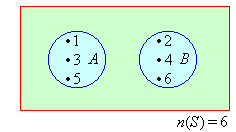



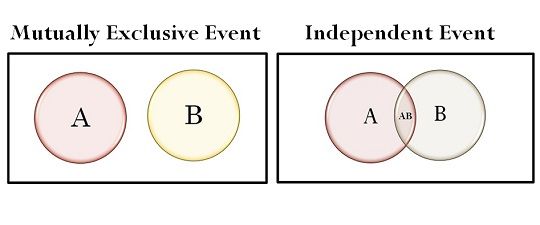


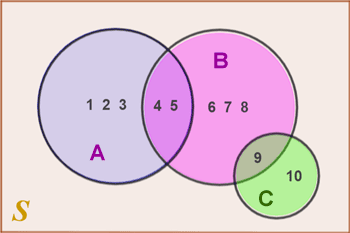



/mutually-56b749655f9b5829f8380e1f.jpg)


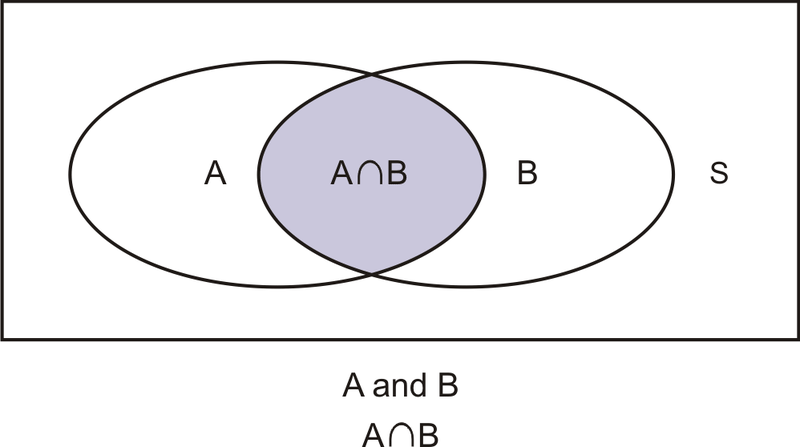
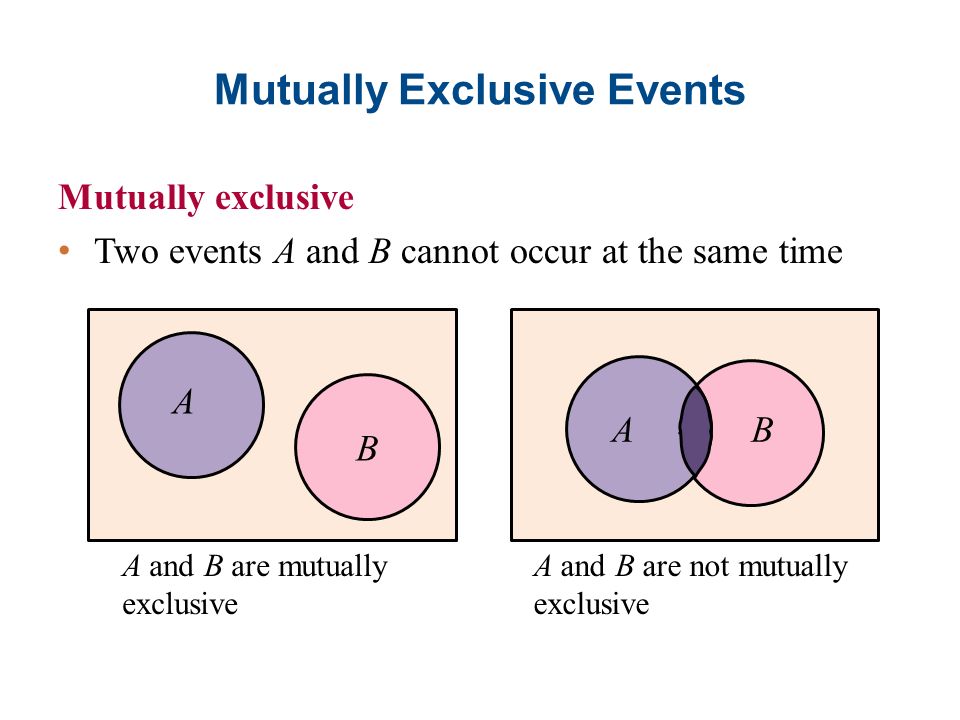



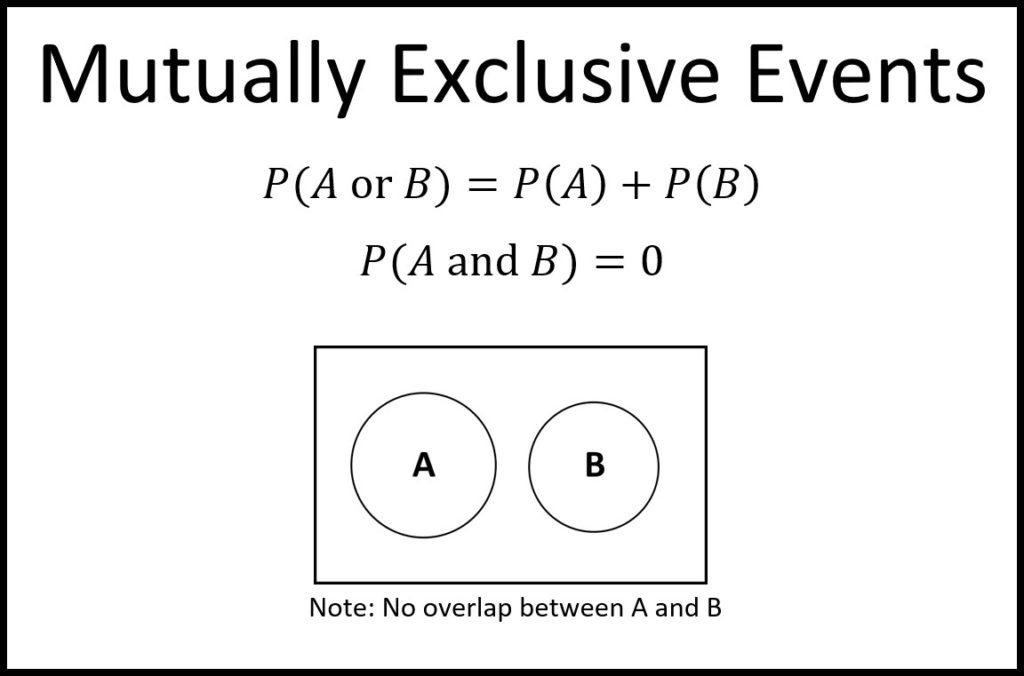





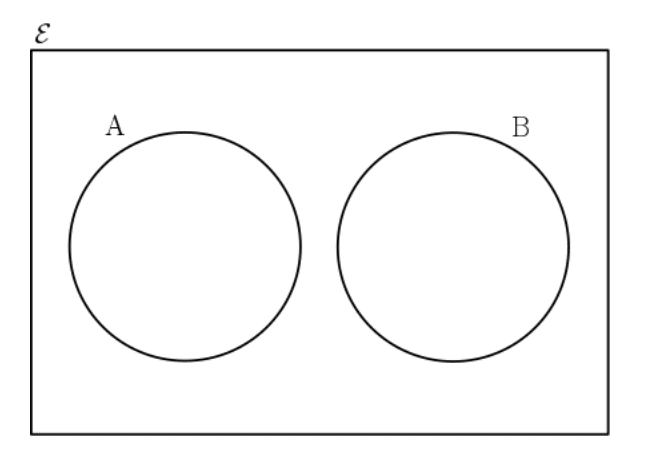

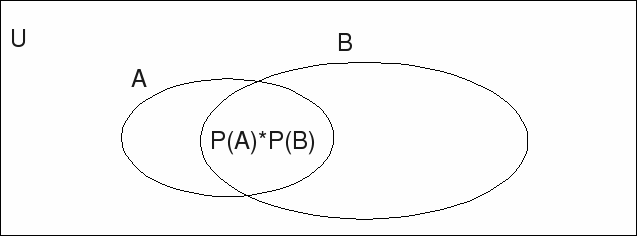


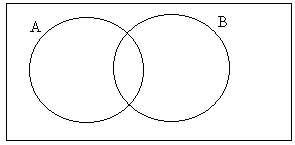
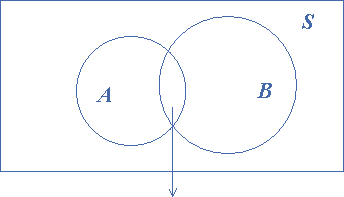



/mutually-56b749655f9b5829f8380e1f.jpg)
0 Response to "38 mutually exclusive venn diagram"
Post a Comment